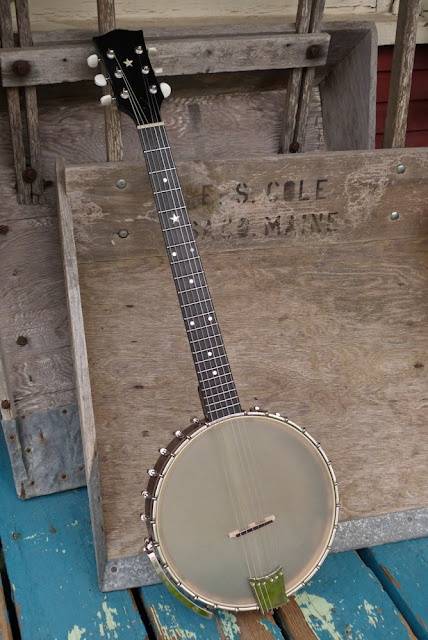2014 Gold Tone BT-2000 6-String Banjitar
Ah, the venerable banjo-guitar! ...or, in modern parlance, banjitar. Setup-wise, I think these are perhaps the least-understood of the banjo-family after the banjo-mandolin (which are a menace to anyone who hasn't "figured them out" by working on dozens of them). Gold Tone was clearly working on solving many "banjitar" lackluster issues with this model, however, and aside from Deerings (which are a different flavor), I can't think of any current-day production banjitar that's better than this one.
The best features include a bigger 12" pot, simple hoop tonering, good-quality hardware, a long 25 1/2" scale length (many "imports" use a short scale that lends a non-banj-ish tone/sustain bent to the instruments), and a comfortable, "modern electric-feeling" neck with a gracious 1 11/16" nut width. It's also stock with a bone nut, practical armrest, and adjustable tailpiece (which, for tone-tweaking freaks, is a must).
This one came in for consignment "as-new" and complete with a hex wrench rubber-banded to the coordinator rods at the rear. My work was to restring it with what I think works best on banjitars (a set of "balanced tension" electric guitar 10s -- with an unwound G), compensate the bridge for said strings, and set it up. That was it -- and she plays perfect with 3/32" EA and 1/16" DGBE at the 12th fret. It likes getting fingerpicked best, I must say, but if you crosspick with a light/floppy flatpick you can get a really good sound out of it, too.
The 12" rim (11" is standard, these days) gives the bass frequencies some room to stretch and is something I'm very thankful for. It suits the extended range of the instrument a lot better than a standard 11" rim, though I'd imagine if the head was too slack it would probably get a bit muddier than the 11" would.
I'm also thankful for the factory-original Remo Renaissance-style head (my favorite type).
The sealed tuners are a bit out of place on a banjo but do function very well -- and at least the buttons are white plastic and rounded rather than the horrid trapezoid-style metal buttons we're all familiar with.
The nut is 1 11/16" and bone and the headstock seems to be veneered in ebony. The truss rod works perfectly and the neck is straight.
The board feels like it has about a 14" radius and is ebony with pearl dots. The frets are, basically, unplayed, and good medium-jumbo stock.
I've recut the bridge top to compensate for the unwound G string. The bridge itself is radiused to match the board, too.
The adjustable tailpiece is a big plus for tone-freaks as you can dial-in more snap/punch/brightness or dial it back out for more warmth/sweetness. It's a simple, practical design, too.
As you can see, the rim has a double coordinator-rod setup which is just what you want to see on a modern banjo -- it's practical and sturdy and allows for action adjustments on-the-fly via adjusting the bolt under the tailpiece on the lower rod.
The hex wrench is for tightening up the hook/nuts and the foam directly below the tailpiece shoved-up against the head is my usual bit to cut down on "unwanted overtones" -- you know, that over-ringy sound you get on banjos. It's totally optional but tends to help clear-up your notes when playing faster passages.
The rim itself is all maple and has a rosewood "cap" on its bottom edge and a "rolled-brass" tonering on its top edge.
The sealed tuners still even have the round, protective film on their backs... and the MiC sticker is still in-place.
The neck wood is stated as "hard rock maple," though this looks more like some form of mahogany to me. The finish is actually a sort of greyish-brown sunburst color in person. It's kinda neat.





















Comments